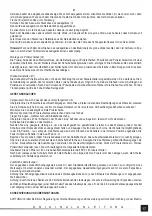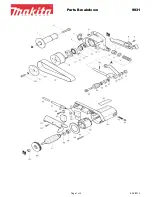
13
O R I G I N A L I N S T R U C T I O N S
GB
TOOL USE
Make sure the battery has been disconnected from the tool.
Check the polishing disc for damage. If any cracks, scratches or other damage are visible, replace the disc with a new one free of
these defects. It is forbidden to work with damaged discs!
Install the additional handle and the polishing disc.
Select the type of polishing pad appropriate for the type of work.
Wear eye protection, hearing protection and work gloves.
Check that the switch is in the „o
ff
” position and is locked - it cannot be pressed.
Connect the battery to the tool.
Adopt a suitable posture to ensure balance, start the tool by pressing and holding the switch on the back, and then move it forward.
The switch has the option of locking in the on position - I. The tool is stopped by pressing the switch in the rear position. The spring
will move the switch to the o
ff
position - O.
Start work by gently applying the side surface of the pad to the workpiece (V). Do not exert too much pressure on the workpiece
during operation. Move the tool to and fro with smooth movements. Observe the e
ff
ects and adjust the torque speed and pressure
of the polishing disc. If polishing agents are used, read the documentation provided with them before starting work.
Do not overload the polisher, the temperature of the external surface must never exceed 60
O
C.
After releasing the switch, the disc will keep spinning for some time. Do not put the polisher away until the disc has come to a
complete standstill.
Additional notes
The declared total vibration value has been measured using the standard test method and can be used to compare one tool to
another. The declared total vibration value can be used in the initial exposure assessment.
Caution! The vibration emission during tool operation may di
ff
er from the declared value, depending on the way the tool is used.
Caution! Safety measures to protect the operator, which are based on an assessment of exposure under actual conditions of use
(including all parts of the work cycle, such as the time when the tool is switched o
ff
or idle and the activation time), must be speci
fi
ed.
MAINTENANCE AND OVERHAUL
ATTENTION! Before any adjustment, technical service or maintenance operations unplug the tool. Once the operations have been
fi
nished, the technical conditions of the tool must be assessed by means of external evaluation and inspection of the following
elements: body and handle, conductor with a plug and de
fl
ection, functioning of the electric switch, patency of ventilation slots,
sparking of brushes, noise level of functioning of bearings and gears, start-up and smoothness of operation. During the guarantee
period, the user cannot dismantle the electric tools or change any sub-assemblies or elements, since it will cancel any guarantee
rights. All irregularities detected at overhaul or during functioning of the tools are a signal to have the tool repaired at a service
shop. Once the functioning has been concluded, the casing, ventilation slots, switches, additional handle and protections must be
cleansed with a stream of air (at a pressure not exceeding 0.3 MPa), with a brush or a cloth without any chemical substances or
cleaning liquids. Tools and handles must be cleansed with a clean cloth.
Summary of Contents for YT-82920
Page 20: ...20 RUS residual current device RCD...
Page 21: ...21 RUS Li Ion 10 20 500 0 30 50 70...
Page 22: ...22 RUS II II III IV I V 60 C...
Page 23: ...23 RUS 0 3 MPa...
Page 25: ...25 UA residual current device RCD...
Page 26: ...26 UA Li Ion 10 20 500 0 30 50 70...
Page 27: ...27 UA II II III IV I O V 60 o c...
Page 28: ...28 UA 0 3 MPa...
Page 70: ...70 GR RCD RCD...
Page 71: ...71 GR Li ion 500 0 30 50 70...
Page 72: ...72 GR III IV I O V...
Page 73: ...73 GR 0 3 MPa...














































